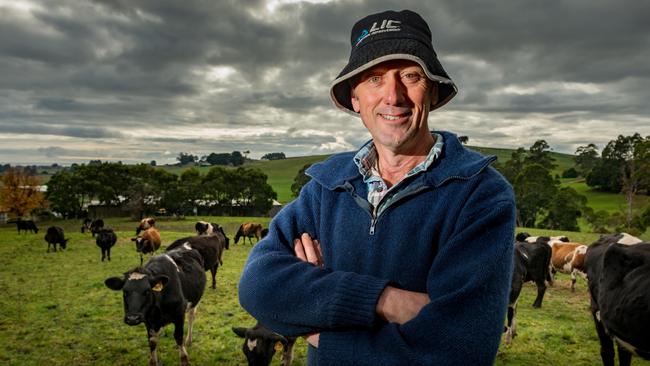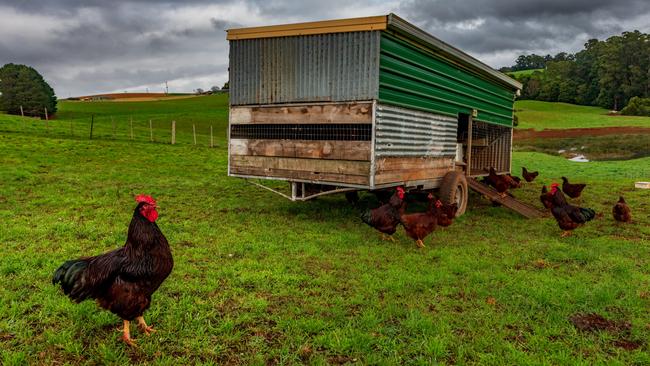Tasmanian dairy farmer works with nature to reap rewards
A simple approach to business helps this Tasmanian dairy farmer tackle some big operational issues.

FOR the Framptons, midwinter marks the beginning of calving on their Tasmanian dairy farm.
Calving 400 crossbred milkers in a tight group may makes sense for the family’s business, but for Rob Frampton it most importantly “suits the farm”.
“We calve everything in seven to eight weeks. It’s our pasture management system,” he said.
“Virtually we have got everything in and milking by the time the spring flush hits, so we can maximise our use of spring pasture.
“Because our farm can be dry, if it dries off early, it gives us that opportunity to cull, and we haven’t got late calvers who only do half a season.
“It’s a massive thing for profit. The quicker you get them in, and the more you can use your spring pasture, the better.”
This short, seasonal calving pattern also provides labour efficiencies and herd fertility benefits, but it is clear this farm at Gawler on the island state’s northwest coast operates to match the climate.
It is also finely tuned to turn a profit, year-in, year-out.
The Framptons are annual entrants in the Tasmanian Dairy Business of the Year awards, a farm and financial benchmarking competition.
Their cost of production before interest and tax sits at $3-$4 a kilogram of milk solids, depending on the season, while Rob said his earnings before interest and tax were always more than $1.50/kg of MS and last season it exceeded $3/kg of MS.
“We are usually one of the lowest cost (farms),” Rob said.
“We like to keep it simple. It’s profitable and simple and I just hate wastage.”
According to the 2018-19 Tasmanian Dairy Farm Monitor Project, the average EBIT — the gross farm income less variable and overhead costs — for the 32 participating businesses was $1.44/kg of MS.
Those in the top 25 per cent of this group had an average EBIT of $2.27/kg of MS.
The same report recorded the average cost of production – variable plus overhead costs, changes in fodder inventory and livestock trading losses – to be $5.42/kg of MS.
For the top 25 per cent the cost was $3.78-$4.43/kg of MS.
CARBON CARETAKERS
THIS year, Rob, his parents, Norm and Lesley, and employee Linda Pickford were recognised at the awards for their commitment to the environment.
Planting trees, not making silage, not using nitrogen, and applying only maintenance levels of other fertilisers all contributed to the award.
But the Framptons’ commitment to reducing their business’ carbon footprint goes far beyond the public recognition.
It is ingrained in their everyday life.
For example, they are one of only a few farmers who have a battery-powered quad bike.
They also have solar panels, 40 kilowatts’ worth, which has reduced power costs at the dairy by two-thirds.
Timers help manage the electricity usage in the dairy and for other equipment.
The one farm tractor also only clocks 300 hours a year or about six hours a week.
Contractors spread fertiliser and bale hay.
Everything else is done using this tractor.
Setting the farm up to be “as environmentally friendly as possible” matches Rob’s personal philosophy and desire to reduce his carbon footprint.
But the sixth-generation dairy farmer said addressing climate issues within his business could have ramifications beyond the farmgate.
“There are environmental concerns about eating meat and milk and we want to prove we are doing the right thing,” Rob said.
“Also, climate change will affect us; we rely on the climate.
“We are trying to set ourselves up to cope with the environment and have as lower inputs as possible.
“That’s the aim, and to reduce costs.
“Who knows what the future fuel and power costs are going to be?
“While we can, we may as well try and lower them.”

SILAGE SAVINGS
THIS environmental push has not come at the expense of profit, with Rob insisting his business plan is simple, but “different”.
For example, silage has not been cut on-farm for years, mostly to reduce plastic wastage, but also because Rob said it did not make sense for their farm.
“It’s because we don’t have excess (pasture) to make (silage) and virtually when we need it, it is only a few weeks after we make it, so we may as well defer graze it,” Rob said.
“Silage, if you add labour, wastage and cost it per energy, is one of the most expensive feeds on the farm.”
The Framptons’ farm is 207ha and includes 75ha of lateral sprinkler irrigation, powered by off-peak electricity.
A mixture of perennial ryegrass and clover with some chicory and plantain dominate all paddocks.
No nitrogen has been applied for more than 10 years.
“Most of the nitrogen fertiliser you put on during the year grows more feed in spring and in turn makes more silage,” Rob said.
“And we have a lot of clover in our pasture. By not using nitrogen we are encouraging clover and (from this) we get a lot of free nitrogen.”
A carefully managed grazing system ensures optimisation of spring pastures.
This is also how the business avoids resowing paddocks, according to Rob.
Their system includes keeping on top of pasture during spring, by grazing it to low residuals, before implementing deferred grazing at the end of spring.
“Yes, when it bulks-up we lose a bit of quality,” Rob said of the pasture during spring.
“But it is very cost effective (and) we can slow the rotation down into summer so we can slow the grazing down and have the optimum (amount) through summer.”
In the past few years, a couple of chicken caravans, each containing 50 to 60 birds, have followed the cows for pasture fertilisation and renovation.
“They eat a few of the bugs, harrow the ground a bit and spread a bit of manure around, level off a few of the cow pats,” Rob said.
Inspired by “environmental farmers” in the US, Rob created the caravans out of scrap and donates the eggs to charity.
SEAWEED TREAT
PROVIDING adlib seawater for the milking herd is another concept Rob introduced after reading about its potential health benefits.
Admitting he has “no idea if it does anything or not”, he said the cows enjoy it, it’s free, and he’s noticed any with health issues “hang around” the water.
Not that animal health has been an issue.
Rob said his average annual bulk milk cell count ranged from 150,000 to 180,000 cells/ml. Last season he used antibiotic to dry-off only 25 cows, those that had mastitis during their lactation.
Running crossbreds with a liveweight of about 450kg, Rob has introduced the French origin, dual-purpose Normande into his breeding program to diversify the business.
While it is only early days, he said the Normande genetics would provide a beef market for progeny without too many milk losses.
Rob does not like to push production too hard and is not afraid to dry off the herd early if it is not profitable to produce milk.
The Frampton herd averages 300-350/kg of MS a cow, depending on lactation length, with grain fed in the bail ranging from 500kg to 800kg a cow per lactation depending on the season and economics.
Half the 200-400 round bales of pasture hay used each year are bought in.
Stocking rate has been used to escalate or de-escalate the business to adjust to seasonal or farmgate milk price opportunities or challenges.
HERD PRESERVED
IN A good season, the Frampton’s do not cull their milking herd and if it is profitable, they can increase the amount of grain fed in the bail.
This season all cows were milked through to make the most of the conditions, but in a “normal” year, culling begins at Christmas, and this is based on production, mastitis and fertility.
Labour saving has also been a business priority, with the introduction of automatic gate latches saving time, while a specialised calf trailer means they never have to lift a calf and it allows them to calve cows further from the dairy.
While it may seem as though organic milk production would fit the Frampton’s farm business, Rob has not been so sure.
“I don’t like all paperwork,” he said.
“I don’t want to do organic to chase the extra money, I want to do the best for the cows and that is not always organic.
“The best for the farm, environment and profitability is not always organic either.”
Reflecting on his environmental aspirations, Rob said producing a commodity meant differentiating their product was impossible, but he and his family persist with their principles.
“I’m trying to produce what I think is the best milk, but it all goes into the truck with the rest,” he said.
“We just have to do what we think is right, our own philosophy, and hopefully stay ahead of the ball.”
MORE
MILK PRICES 2021-22: BULLA RAISES OPENING RANGE FOR THIRD TIME BEFORE DEADLINE
HOW THE WEEKLY TIMES HELPS DAIRY FARMER BUSINESS SUBSCRIBERS
LIVESTOCK THEFT: RECORD NUMBER OF CATTLE STOLEN, ONLY HANDFUL OF ARRESTS IN VICTORIA


